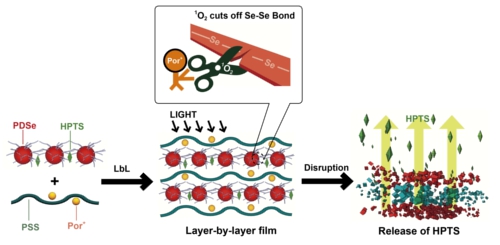Huifeng Ren, Yaoting Wu, Yang Li, Wei Cao, Zhiwei Sun, Huaping Xu, and Xi Zhang
Small, 2013, 9, 3981-3986.
A photoresponsive polyelectrolyte multilayer film containing a diselenide functional group is fabricated using an unconventional layer-by-layer method. The polycation backbone is constructed through copolymerization of di-(1-hydroxylundecyl) diselenide and 1,4-bis(2-hydroxyethyl)piperazine with 2,4-diisocyanatotoluene. A common polyanion poly(styrene sulfonate) is selected as the polyanion. The obtained film can be gradually disrupted under the irradiation of mild visible light, and this process can be monitored with UV–vis spectroscopy. The residue of the film is estimated to be 17% after 5 h of irradiation. The intensity of the visible light can be as low as 50 mW cm−2, which is even weaker than the sunlight. The cytotoxicity of the building blocks is evaluated in MTT assays using human hepatic cell line (L-02), and the results are satisfactory. Further tests show that cells can grow in a regular manner on this film, indicating good biocompatibility. In addition, the film can be used to achieve cargo loading and controlled release. Considering that light can not only trigger controlled release but also act as part of the therapy itself (photodynamic therapy), this system shows hope for further development into a platform for the combination of chemotherapy and photodynamic therapy, especially for applications concerning skin.

